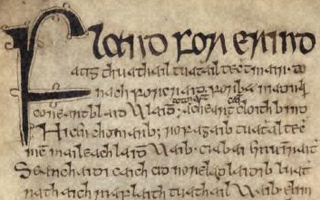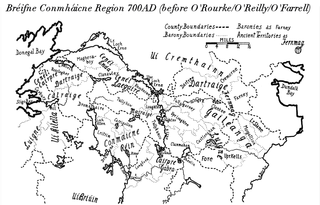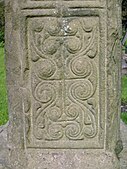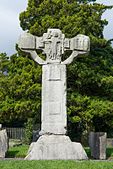Toirdhealbhach Mór Ua Conchobhair anglicised Turlough Mór O'Conor, was King of Connacht (1106–1156) and High King of Ireland.
Domnall mac Áedo, also known as Domnall II, Was an Irish king and son of Áed mac Ainmuirech and his consort Land, the daughter of Áed Guaire mac Amalgada of Airgíalla. Domnall was High King of Ireland from 628 until his death. He belonged to the Cenél Conaill kindred of the Northern Uí Néill.
Congal Cáech was a king of the Cruthin of Dál nAraidi in the medieval Irish province of Ulaid, from around 626 to 637. He was king of Ulaid from 627–637 and, according to some sources, High King of Ireland.

Flann Sinna, also known as Flann mac Máel Sechnaill, was the son of Máel Sechnaill mac Máele Ruanaid of Clann Cholmáin, a branch of the Southern Uí Néill. He was King of Mide from 877 onwards and a High King of Ireland. His mother Land ingen Dúngaile was a sister of Cerball mac Dúnlainge, King of Osraige.
Cathal mac Finguine was an Irish King of Munster or Cashel, and effectively High King of Ireland as well. He belonged to the Eóganacht Glendamnach sept of the dominant Eóganachta kin-group whose members dominated Munster from the 7th century to the 10th. His father, uncle, grandfather and great-grandfather had also been kings of Cashel, as were his son and grandson.

Máel Sechnaill mac Domnaill, also called Máel Sechnaill Mór or Máel Sechnaill II, was a King of Mide and High King of Ireland. His great victory at the Battle of Tara against Olaf Cuaran in 980 resulted in Gaelic Irish control of the Kingdom of Dublin.
Donnchad Donn mac Flainn was High King of Ireland and King of Mide. He belonged to Clann Cholmáin, a branch of the southern Uí Néill.

The Battle of Tara was fought between the Gaelic Irish of Meath, led by Máel Sechnaill mac Domnaill, and the Norse Vikings of Dublin, led by Amlaíb Cuarán. It took place near the Hill of Tara in Ireland in the year 980. The battle was a devastating defeat for the Vikings and led to the Irish regaining control of Dublin.
Flaithbertach Ua Néill was king of Ailech, a kingdom of north-west Ireland. He abdicated in 1030 and undertook a pilgrimage to Rome, for which reason he was known as Flaithbertach an Trostáin. Following the death of his son Áed in 1033, Flaithbertach left his retirement and resumed the leadership of the Northern Uí Néill.
Ruaidrí Ua Conchobair, called Ruaidrí na Saide Buide was King of Connacht, perhaps twice.
Conchobar mac Taidg Mór was a King of Connacht from the Uí Briúin branch of the Connachta. He was the grandson of Muirgius mac Tommaltaig, a previous king. His father Tadg Mór had been slain fighting in Muirgius' wars versus the minor tribes of Connacht. He was of the Síl Muiredaig sept of the Uí Briúin. The Ó Conchobhair septs of Connacht are named for him.
Events from the 9th century in Ireland.
Events from the 11th century in Ireland.
Mac Maoláin Gaelic-Irish surname.

Ivar of Waterford was the Norse king of Waterford from at least 969 until his death in the year 1000, and also reigned as King of Dublin, possibly from 989 to 993, and certainly again for less than a year between 994 and 995, returning after his expulsion from the city in 993 by Sigtrygg Silkbeard, who would expel him for good the next time.
The Ciannachta were a population group of early historic Ireland. They claimed descent from the legendary figure Tadc mac Céin. Modern research indicates Saint Cianán and his followers may have been the origin behind the tribal name as it is a late construction similar in form to Eóganachta and Connachta. They first appear in historical sources in the 6th century, and were found in several parts of the island, including in Brega and Airgialla. The Ciannachta groups were absorbed over time.
Toichleach Ua Gadhra, King of Gailenga, in medieval Ireland, died in 964.

Gailenga was the name of two related peoples and kingdoms found in medieval Ireland in Brega and Connacht.
Luighne Connacht was a territory located in north-central Connacht, on the borders of what is now County Mayo and County Sligo, Ireland.
The Fortúatha were "kingdoms not ruled directly by members of the dominant dynasty of a province". They have also been described as "in effect, people belonging to a different stock from that of the rulers of the territory", yet sometimes enjoying a position of favour with the ruling people.










